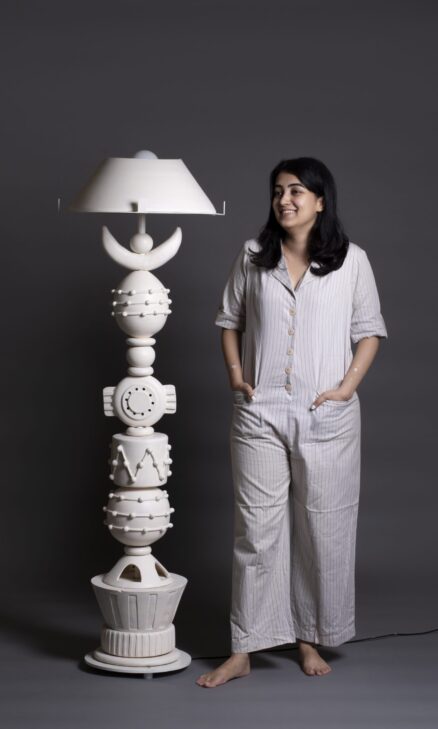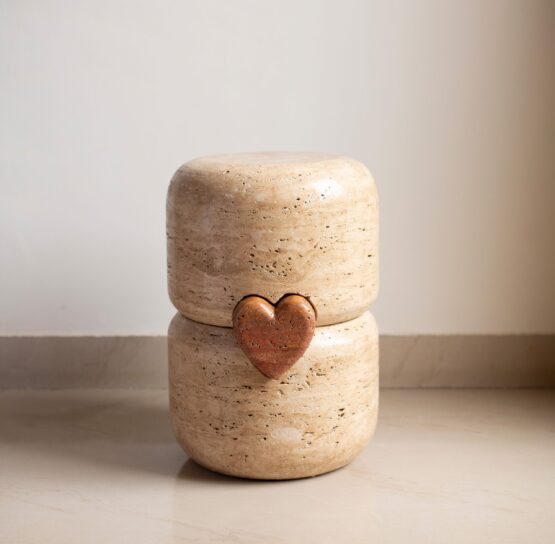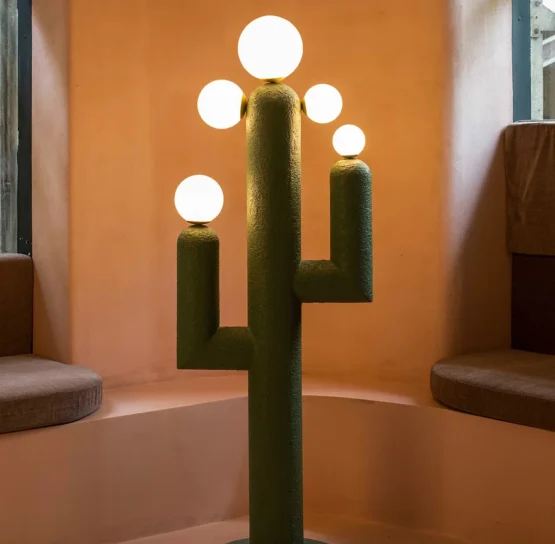Harshita Jhamtani
Mumbai-based architect-turned-designer Harshita Jhamtani is renowned for her innovative, sculpturesque furniture and lighting designs that blend art with function, emphasizing material exploration and unique forms.
Mumbai-based architect-turned-designer, Harshita Jhamtani’s rise as one of the innovators in the Furniture and Lighting industry has been defined by the idiosyncratic forms emerging in her designs. A refreshing welcome from traditional concepts, they reveal how furniture can be interpreted as art pieces and sculpturesque designs. Embodying a distinct aesthetic, these pieces demand attention from anyone who steps into the space. Following her education, a brief stint at an architectural firm sparked Jhamtani’s interest in furniture, and after working at JSW, she started her eponymous design studio. What makes these designs unmistakable are a few key aspects considered in each product. Whether it’s a floor lamp, wall light, table, or ottoman, Jhamtani’s approach centres on material exploration and the innovative use of unique forms. It's also noteworthy how her creativity remains uncompromised across the designer’s work—whether drawing inspiration from childhood memories shared with her sister or reimagining the form of a cactus plant into a functional piece. In Harshita’s designs, the choice of materials also shape the texture and overall feel of each piece. The use of clay brings a certain playful and raw quality, while marble and the speckled patterns of terrazzo offer a more polished and refined look to her lighting designs. An eloquent display of function and art co-existing in design, Harshita has been able to create a signature style for herself, most notably seen in her handmade Asteroid Floor Lamp. It features removable clay segments that can be rearranged as required, garnering attention from publications like Architectural Digest.



Harshita speaks to Blur The Border :
Blur : You have a background in architecture. Have you come across any synergies between your old and new disciplines as a furniture and light designer?
Harshita : Absolutely! Design, whether it’s fashion, jewelry, or products, often overlaps and draws inspiration from one another. For me, architecture is the foundation of all design disciplines. It not only taught me technical skills but also instilled a way of thinking—approaching problems creatively and understanding how to cater to a specific audience. The principles I learned in architecture naturally extend into my work as a furniture and lighting designer.
Blur : You have established a distinct signature aesthetic for your designs. Do you find it restrictive as an artist to ensure that each piece looks like a Harshita Jhamtani creation?
Harshita : From a business perspective, yes, there is always the need to ensure that each piece reflects our studio's identity. It's similar to when you see a Sabyasachi creation—you immediately recognize it. I followed that approach for a long time, but recently, we've started surprising ourselves by stepping outside the box we created. As creatives, we can sometimes limit our vision by sticking too closely to a signature style, but it's important to keep evolving and exploring new ideas.
Blur : What role does the environment play in your work or fuel your creativity?
Harshita : It plays a huge role. As kids, we were taught to express our emotions through art. I remember realizing that on bad days, my hand would instinctively reach for darker colors, while on brighter days, I gravitated towards lighter, happier shades. Art and design have always been a way to express oneself, and though the process is more layered today, we're still conditioned by our emotions and surroundings in subtle ways. Design often follows a similar process. Different life phases, travel experiences, books, and even movies shape how we think and influence the designs we create. There’s no fixed path to creativity—it often strikes in the most unexpected ways. For instance, our "Bloom" table lamp was inspired by a floral silhouette I noticed on my grandmother’s bedsheet. It's about staying observant and letting what resonates with you guide the process.
Blur : How do you balance the need to be creative with the practical aspects of being a professional artist?
Harshita : I'm a bit of a purist in thinking about an art practice. I believe the only thing that matters is to get good at your art. To enjoy it, to investigate what you want to say, and how to go about doing it in the best way you can. Everything else is just toppings and is easy to put into place if the work is good enough. I see no ‘practical’ aspects that hinder the creative process. Well, sometimes I do have to do boring admin work, but that's a negligible bother compared to this vast task and gift of creating.
Blur : Do you have a definitive process while creating? Are there any habits or rituals that help you get into a creative mindset?
Harshita : I think we started this studio not purely out of creativity, but by identifying gaps in the market and taking a practical approach. We focused on what the market needed and designed products around that. While we’ve had some very creative moments and made products we’re proud of, our foundation has always been about solving problems, which has shaped a different kind of creativity. Earlier, I preferred working in isolation, but over time, I’ve realized that having a team around can be more inspiring. With experience, we’ve also become more cautious, often opting for the safer, more marketable path instead of riskier, experimental ideas. I’m hoping to change that now and embrace more creative freedom. Maybe in a year, I’ll have a clearer perspective on this shift.
Blur :What drew you towards materials such as Clay, marble and your inhouse clay paste in your designs and are there any other mediums you would like to explore in the future?
Harshita : It all happened by chance. During the lockdown, like many others, I found myself exploring new activities. While experimenting with hair color and engaging in ludo tournaments, I decided to teach myself clay modeling. Fortunately, I had an excellent teacher nearby as things began to reopen. I spent four months training and realized I could create lights and furniture using clay. I fell in love with the material's complexity and simplicity.
As we began building pieces, we encountered size restrictions that prevented us from making larger floor lamps. This led to the development of our in-house clay paste, which we apply to metal sheets to achieve a similar aesthetic. We also noticed that our sales were limited in northern India, prompting us to explore marble to appeal to a different audience. Currently, we are working with cast aluminum, recycled plastic, and even some fabric.
In the future, I would love to explore more materials and travel across the country to discover art forms that we haven't fully tapped into as a nation.
Blur : If you were to collaborate with another artist, within or outside of your discipline, what is one collaboration you would love to do?
Harshita : I would love to collaborate with a specialist in materials that help remove excess CO2 from the environment, like algae-based materials or natural air purifiers. I've always wanted to create products using innovative materials that can add real value to a space, not just aesthetically but also environmentally. This collaboration could lead to unique designs that not only enhance the beauty of a home but also contribute positively to the air quality and overall well-being of its inhabitants. It would be exciting to explore how these materials can be integrated into furniture and lighting, creating functional art that supports a healthier environment.
Blur : In recent years, the importance of handcrafting has risen to match that of technology. How do you envision these two elements coexisting in the future, and how can future designers navigate this balance skillfully?
Harshita : For a while, it seemed like a choice between handcrafting and technology, but I believe they should go hand in hand. It’s crucial to understand why this shift is happening and why people are gravitating back to handmade products. We, as a studio, have never liked the idea of mass manufacturing, as each home is unique and reflects the personality of its inhabitants. It's essential for a home to capture that individuality; we can’t all live in spaces that look identical. Handmade products embody this uniqueness, conveying the message, "This was made just for you, and there is nothing else like it." If we can preserve this essence while supporting the artisans—who are the true makers and creators—and integrate technology to empower them, that’s when we will find the ideal balance. Future designers can skill fully navigate this coexistence by embracing both worlds, fostering creativity, and celebrating individuality through their work.
Blur : How do you see the role of furniture design evolving in the context of changing consumer lifestyles and home spaces?
Harshita : The role of furniture design is evolving significantly due to changing consumer lifestyles and the increased time people spend at home. With a growing awareness of ergonomics, consumers are prioritizing their well-being and comfort when selecting furniture. In the past, people often relied on local carpenters for custom pieces, but now there’s a shift toward hiring interior designers and investing in branded furniture, especially from Indian companies. The COVID-19 pandemic has further accelerated this trend, as people have become more conscious of their living spaces and how they reflect their personal style and needs. Even items that were once considered non-essential, like decorative floor lamps, are now sought after as people look to enhance their home environments. This evolution indicates a deeper appreciation for thoughtful design that combines functionality, aesthetics, and wellness, ultimately shaping the future of furniture design.
Blur : There are so many design-centric brands emerging in India. How do you think the industry can further promote or bring them into the spotlight?
Harshita : The strength of the design community in India lies in its collaborative spirit. Instead of viewing each other as competitors, many of us work together, referring clients to one another based on who would be the best fit for the project. This approach not only supports each other but also enriches the overall design experience for our clients.
Also it has happened so many times, if a client purchases a living room light from me, they might purchase a Shailesh Rajput for the bedroom, Jade Design for the guest room, and Length Breadth Height for the bathroom. There is more than enough space for everyone in the market. With India being such a vast market, there’s ample opportunity for emerging brands to find their unique audiences. Recently, a few of us showcased our work at Milan Design Week, where we discussed the need for a supportive community for product designers in India. We’ve since formed an initiative that currently includes about 15 studios, and we aim to expand this network in the coming months. By presenting a united front, we can collectively promote our designs, share resources, and elevate the visibility of all design-centric brands in the industry.
Blur : Any artist or designer you would like to give a shoutout to in the homegrown space?
Harshita : Absolutely, there are so many talented studios and designers in India that I admire. Since we’re focusing on community, I’d like to give a shoutout to Length Breadth Height, White Studios, Jade Design House, Shailesh Rajput Studio, Stem Design, and Olie Lighting Studio. These are just a few among many that are making significant contributions to the design landscape in our country. Each of them brings a unique perspective and creativity that enriches the homegrown design scene, and I'm excited to see how we can continue to support and uplift one another.
Know more about Harshita:
Website: https://www.harshitajhamtani.com/
Instagram: @harshitajhamtanidesigns